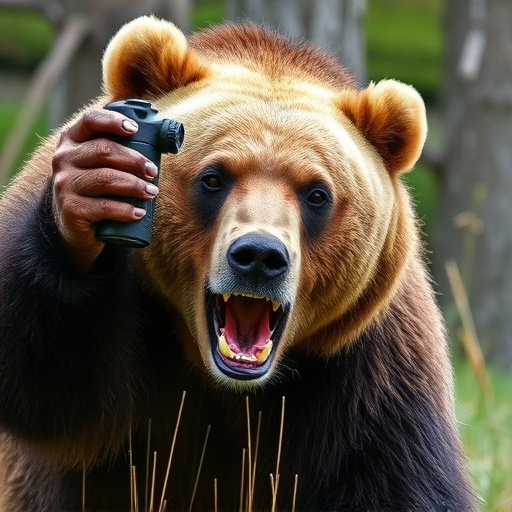Understanding bear behavior is crucial for outdoor safety in areas with bear populations. While bear pepper spray is a valuable deterrent against aggressive bears, it must comply with TSA restrictions on liquids and aerosols. To ensure compliance while exploring bear country, opt for smaller, approved bear spray containers. In addition to bear pepper spray, consider noise makers, metal objects, and reflective clothing to enhance safety by startling bears and signaling human presence.
In the great outdoors, encountering aggressive bears is an increasingly common concern. Understanding bear behavior and their unique attractions to humans is the first step in ensuring safety. This article explores effective deterrents, with a focus on bear pepper spray as a popular choice. We delve into the Transportation Security Administration (TSA) restrictions surrounding bear pepper spray, offering insights for responsible outdoor enthusiasts. Additionally, alternative measures are presented for those seeking comprehensive protection beyond traditional sprays.
- Understanding Bear Behavior and Their Attraction to Humans
- The Role of Pepper Spray in Bear Deterrent Strategies
- TSA Restrictions on Bear Pepper Spray: What You Need to Know
- Alternative Measures for Outdoor Safety Beyond Pepper Spray
Understanding Bear Behavior and Their Attraction to Humans
Understanding bear behavior is crucial when it comes to outdoor safety, especially in areas where bears are prevalent. Bears, particularly aggressive species like grizzly bears or black bears, can be attracted to humans for various reasons. One of the primary factors is food sources; they may follow the scent of food, garbage, or even cooking fumes. It’s essential to store all food securely when camping and never leave any leftovers behind.
Bears also exhibit curiosity and a strong sense of protection for their cubs and territories. They might approach humans out of sheer curiosity, mistaking them for potential mates or rivals. To reduce these encounters, it is recommended to make yourself visible by talking loudly while hiking and wearing bright clothing. Additionally, carrying bear pepper spray is advisable, keeping in mind the TSA restrictions on liquids, as it can be a game-changer in deterring an aggressive bear attack.
The Role of Pepper Spray in Bear Deterrent Strategies
Pepper spray has emerged as a popular and effective tool in bear deterrent strategies, especially for outdoor enthusiasts and those living in bear country. Its active ingredient, capsaicin, is a natural compound that causes temporary blindness, congestion, and pain in the eyes and respiratory system when inhaled. This potent irritant can create a critical window of opportunity for escape or evacuation when used against aggressive bears.
However, it’s essential to consider the TSA (Transportation Security Administration) restrictions on bear pepper spray. The TSA prohibits liquids, aerosols, gels, and gel-like substances in carry-on luggage due to security concerns. This means that traditional bear pepper spray cans are not allowed onboard flights. As a result, individuals traveling to or through areas with high bear activity must opt for bear spray containers approved by the TSA, which are typically smaller and designed to meet airline safety regulations. Knowing these restrictions can help outdoor adventurers plan and prepare accordingly, ensuring they have the necessary bear deterrents while adhering to travel security measures.
TSA Restrictions on Bear Pepper Spray: What You Need to Know
When preparing for outdoor adventures in areas known for aggressive bears, it’s crucial to understand the TSA (Transportation Security Administration) restrictions on bear pepper spray. While bear pepper spray is a vital tool for self-defense against these dangerous animals, travelers should be aware of what types of sprays are permitted and how they can carry them. The TSA permits the transport of bear pepper spray in checked baggage but has strict guidelines regarding its packaging and contents. Only aerosol cans that meet specific size and design requirements are allowed, ensuring the spray does not pose a risk for explosion or excessive spraying during transit.
Additionally, it’s important to note that liquid or gel forms of bear pepper spray are not permitted as carry-on items due to security concerns. These restrictions mean outdoor enthusiasts must plan ahead and ensure they have the correct type of spray approved by the TSA. Properly equipped with the right kind of bear pepper spray, individuals can enhance their safety while hiking or camping in bear country.
Alternative Measures for Outdoor Safety Beyond Pepper Spray
When considering outdoor protection against aggressive bears, it’s important to look beyond just bear pepper spray. While effective, traditional spray options face TSA restrictions for travel and may not always be readily available in certain locations. Fortunately, there are several alternative measures that can enhance your safety in bear country.
One option is the use of noise makers like whistles or shake-and-shake devices. These tools can startle bears and give you valuable time to retreat or prepare for an encounter. Additionally, bearing a loud alarm or even a simple metal object like a pot or pan can create noise that might deter an approaching bear. Wearing bright, reflective clothing and carrying a high-pitched whistle attached to your person is another effective strategy. Such visible and audible cues can help bears identify you as a human and potentially avoid conflict.
In conclusion, while bear pepper spray has been a popular and effective deterrent, understanding local regulations, like TSA restrictions on bear pepper spray, is crucial for outdoor enthusiasts. While this method offers immediate protection, exploring alternative measures such as noise makers, light sources, and proper food storage can provide a more comprehensive approach to bear safety. By combining knowledge of bear behavior with diverse deterrents, individuals can minimize encounters and ensure a safer experience in bear country.
